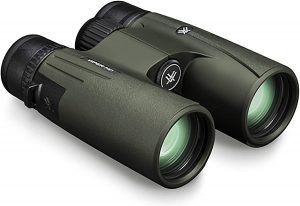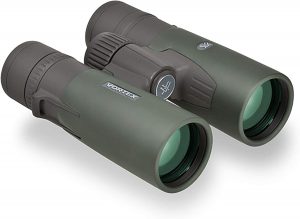Welcome to my article about the Vortex Viper vs Razor!
The Viper and Razor binoculars from Vortex Optics are two of the most popular and highly rated binoculars on the market.
Below I will compare the 8×42 and the 10×42 models of each binocular side by side to that you can get a good understanding of the pros and cons of each, and decide which one is right for you.
Let’s start off with a quick summary and a comparison table, and then get into the details of each binocular after that!
Table of Contents
Vortex Viper vs Razor: Technical Comparison Table
Here is a side by side comparison of the technical specifications of each binocular in the 8×42 and the 10×42 models.
Vortex Viper vs Razor: Features Comparison Table
Here is a direct comparison of the different features the Viper and the Razor have. You can find out more information about each of these features and the way each one affects the performance of the binoculars a bit further down this article.
Vortex Viper vs Razor: Performance Comparison Table
Here I compare the performance of each binocular in different scenarios to see which one is better. If you’re looking to purchase a Vortex Optics binocular for a specific use such as low light viewing or hunting, this is where you’ll get clarity on which one would be best for you.
You can find more information about the performance of each binocular in each of these scenarios further down this article.
It’s also important to note that both the Viper and the Razor have excellent performance across the board for their respective price ranges, so the table below is more of an indication on which one has a better edge in each scenario, rather than a hands-down winner.
Introduction to the Vortex Viper and the Vortex Razor
Quick Summary of the Viper
The Viper Vortex series is a rugged line of binoculars with amazing features, like rubber armoring, extra-low dispersion glass, and fully multi-coated lenses.
These are also argon purged and O-ring sealed for fog-, water-, and dust-proofing, so they are a great choice for all weather conditions.
Quick Summary of the Razor
The Vortex Razor series is designed to be functional and durable, so they are perfect for any type of activity that you enjoy.
These binoculars feature a magnesium chassis with rubber armoring, XR Plus fully multi-coated lenses, dielectric coatings, and can both handle low light or extra-bright conditions.
Shared Features of the Viper and Razor
There are several features that these two Vortex binocular models share. We’ll discuss these in the following sections.
HD Lens Elements
One feature that is shared by the Viper and Razor models is the HD lens element, which ensures optical precision, no matter what you’re looking at. The resolution is fantastic, with amazing color fidelity for the truest images possible.
XR Fully Multi-Coated
The fully multi-coated lenses are designed to create varying refractive indices to eliminate any chromatic aberrations that could distort the images you’re seeing through the binoculars.
Both of these models include this feature, ensuring sharp images at all times.
Dielectric Coating
The prisms in the Viper and Razor binoculars include dielectric coatings, which are added to maintain bright, clear images, no matter what you’re viewing.
The color reproduction will also be true, so what you see through the binoculars will be identical to the real thing.
Phase Correction
The Vortex Viper and Razor both use phase-corrected Roof prisms, which are designed to maximize the resolution of everything you’re looking at, with the highest contrast possible for the most enjoyable viewing experience you can get.
Adjustable Eye Cups
Adjustable eyecups allow you to turn these pieces up or down, depending on whether or not you’re wearing eyeglasses.
This ensures that you’re always comfortable when looking through them, while still getting a clear view of what you’re trying to see.
Roof Prism
The roof prism design that is used for these two binocular models reduces the size of the binoculars, giving them a more streamlined look and feel. This makes them easier to hold, especially for those with smaller hands.
Waterproof
The O-rings used to seal these two high-quality binocular models ensure that no water can enter them and damage the internal parts.
Those O-rings also protect against dust and debris, so the Viper and Vortex are fully protected in all types of conditions.
Fogproof
Purging the inside of the binoculars with inert gas is the best way to prevent fogging that could ruin your view through the binoculars.
The Vortex Viper and Razor binoculars use argon purging for this, so humidity won’t distort your vision.
ArmorTek/Rubber Armor
The ArmorTek Rubber armor on these two binoculars offers a great deal of protection against scratches, debris, and oil.
It also creates a non-slip grip on the binoculars, so they aren’t as likely to slip from even the sweatiest hands.
Center Focus Wheel
The center focus knob on the Viper and Razor models allows you to adjust the viewing in both barrels at once.
This makes it much quicker and easier to focus on anything you want to see.
Tripod Adaptable
For long-term viewing, a tripod gives your arms a break, which is why both the Viper and the Razor are compatible with tripod adapters.
This allows you to attach them to a tripod or even a car window mount whenever needed.
Diopter
Not everyone has equal vision in both eyes, so a diopter adjustment allows you to get the perfect vision with each eye.
To do this properly with these binoculars, you need to adjust the center focus to give you the perfect view in the left eye, then you can adjust the diopter for clear viewing in the right eye.
Additional Features of the Razor
The Vortex Razor also includes a few features that you won’t find on the Vortex Viper, which may have you leaning towards one over the other.
APO System
The apochromatic (APO) system used by the Vortex Razor binoculars is created using a second ED lens combined with a third non-ED lens placed in the objective lens area.
This brings the red, blue, and green color wavelengths into focus with no blurring or fuzzing between them for crisp, clear images.
Plasma Tech
The Razor includes Plasma Tech coatings, which is an advanced technique that increases durability, plus it improves the light transmission, contrast, and sharpness for better performance.
True Open Hinge
The true open hinge design on the Razor replaces the two small bridges between the barrels on other models with a single thicker piece, which increases the durability of the hinge and reduces the amount of exposed area on the barrels.
Magnesium Chassis
The magnesium chassis used for the body of the Vortex Razor increases the strength and durability for less damage when bumped or dropped.
This material is also lightweight for binoculars that are easier to carry.
Viper Vs Razor: Which One Wins in the Following Scenario
Though they are similar in various ways, the Vortex Viper and Vortex Razor aren’t identical. The following sections determine which one excels in a few specific areas.
Image Clarity
Winner: Razor
Both the Vortex Viper and Razor models offer crisp, clear images in the center of the field of view, though the Viper has a bit more blurring around the edges than the Razor models.
There is also minimal chromatic aberration in both types, so you will get almost the same viewing experience no matter which one you choose.
Field of View
Winner: Razor
When it comes to the field of view, wider is always better to get a larger horizontal picture. This makes it easier to focus on what you want to see.
When comparing the field of view offered by the 10×42 Viper and Razor options, the Razor has a bit more to offer.
The field of view for these binoculars is 362 feet at 1000 yards, while the Viper only has a field of view of 341 feet at 1000 yards.
Low Light Conditions
Winner: Razor
Both the Viper and the Razor include phase-coated prisms, dielectric coatings, and fully multi-coated lenses, so you may expect that they would have the same low light performance. This isn’t the case, though.
This is because the Viper series uses XR fully multi-coated lenses, while the Razor series includes XR Plus fully multi-coated lenses.
That extra Plus in the Razor’s coating increases clarity and optical precision for sharper images, even at dawn and dusk.
Eye Relief
Winner: Viper
Eye relief refers to the distance between the outer surface of the eyepiece lens and your eyes when looking through the binoculars.
This isn’t an issue for those with good eyesight, though those who wear glasses will need longer eye relief for a better view with less strain.
The Viper has a bit more to offer in this area, with an eye relief of 18mm for the 8×42 model and 17mm for the 10×42 binoculars.
The 8×42 Razor binoculars have an eye relief of 17.5mm, with 16.5mm for the 10×42.
Quality of Build/Durability
Winner: Razor
The stronger the build materials are, the more durable the binoculars will be.
The Vortex Viper series uses polycarbonate plastic for the chassis, which is strong, can handle abrupt temperature changes, and is budget-friendly.
This material is a bit heavier than magnesium, though, which is what’s used for the Razor. Despite its light weight, magnesium is still high-strength, making this model a bit more rugged and travel-friendly.
Weight
Winner: Razor
Whether you’re carrying your binoculars around your neck, in your hand, or a carry case, the lighter they are, the longer you can handle keeping them on you.
When comparing the Viper and Razor, there is only a very small difference in this area.
The Viper 8×42 model weighs 24.5 ounces, while the 10×42 weighs 24.9 ounces. The Razor series is only slightly lighter at 24.2 ounces for the 8×42 and 24.8 ounces for the 10×42 binoculars.
Price
Winner: Viper
There are so many identical or near-identical features when comparing the Vortex Viper and Razor models that it may come to price when choosing the right one.
In this area, the Viper comes out on top since the models in this series are about half the cost of the Razors.
Viper vs Razor: Which One to Choose
Not every binocular is the right choice for all the activities you have in mind.
The following sections break down which model to choose for a specific adventure.
Best One Overall
The Viper offers reduced glare, durability, a great low price, and can be used in all types of weather.
Despite all that the Viper has to offer, the Razor may still be the better choice, due to its amazing optical performance and rugged, yet lightweight, build. It also includes a variety of features that the Viper doesn’t offer.
Overall, if you are looking for a high performing yet budget friendly binocular, opt for the Viper. If you’re looking to make an investment in a high quality pair of binoculars that excel in all areas, go for the Razor.
Best One For Hunting
Hunters can spend an entire day wandering in the woods or fields, so their gear needs to be light and easy to use.
The Razor includes a lightweight magnesium chassis, an open-hinge design for an easy grip on the barrel, and has a wide field of view for quick spotting of your prey.
Best One for Bird Watching
The best binoculars for bird watching are 8×42 models with a wide field of view that are easy to focus.
Though both the Razor and the Viper are equal in magnification and focus, the Razor has a wider field of view, plus it offers a bit more clarity for capturing every detail.
Best One For Sailing
For sailors, binoculars with low magnification, a central focus knob, a wide field of view, adjustable eyecups, waterproofing, and fog-proofing are best.
Though both options have similar features in most of these areas, the Razor’s wider field of view puts it over the top.
Best One for Spectator Sports
Most spectator sports involve a lot of movement on the field in front of you, so a magnification of 8x or 10x with a wide field of view is best.
Waterproofing is also a must for outdoor games, plus a lightweight set of binoculars is easier to carry. The Razor 8×42 binoculars have you covered in all of these areas.
Vortex Viper and Razor Price Guide
The Vortex Optics Viper and Vortex Optics Razor binoculars are available from a number of online retailers. I’ve found the best prices on each of the models online and put them in this easy to read table so that you can find the best price on the specific model you want easily.
Vortex Viper vs Razor: Conclusion
I hope this article has helped bring some clarity around the similarities and differences between the Vortex Optics Viper and Vortex Optics Razor binoculars!
Here are some similar articles you may also enjoy:

About The Author:
Hi! I’m Will Scott, the author of this post. I’m an outdoor enthusiast with over 10 years experience. I love trying out new gear and reviewing it so that other adventurers can get the most out of their experiences. I hope you’ve found my website informative, educational and helpful.





